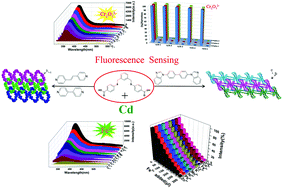From 2D → 3D interpenetration to packing: N coligand-driven structural assembly and tuning of luminescent sensing activities towards Fe3+ and Cr2O72− ions†
Abstract
Three new luminescent transition coordination polymers, namely, {[Cd(L)(4,4-bpy)]·DMF·H2O}n (1), {[Cd2(L)2(bpe)2]·3DMF·2.5H2O}n (2), and {[Cd(L)(bibp)]·2DMF}n (3), (H2L = 4,4′-[benzene-1,3-diylbis(methanediylsulfanediyl)]dibenzoic acid, 4,4-bpy = 4,4-bipyridine, bpe = 1,2-bis(4-pyridyl)ethylene, and bibp = 4,4′-bis(benzoimidazo-1-ly)biphenyl), were solvothermally synthesized using Cd2+ ions and S-containing dicarboxylate acid in the presence of different N coligands. These complexes were fully characterized via elemental analysis, infrared spectroscopy (IR), single crystal X-ray diffraction analysis, and thermal gravimetric analysis (TGA). Complexes 1–3 consist of 2-D structures through the connectivity of similar 1-D Cd-L chains by different N coligands. With an increase in the size of the N coligands, these complexes show structural changes from 2D → 3D with 3-fold interpenetration of complexes 1 and 2 to the 2-D packing modes of complex 3. The luminescence properties of these three complexes were studied in detail. The results reveal that each complex exhibits selectivity and sensitivity towards Fe3+ and Cr2O72− ions, and complex 2 demonstrates the lowest detection limit towards both ions.

- This article is part of the themed collection: Spotlight Collection: MOF Sensors


 Please wait while we load your content...
Please wait while we load your content...